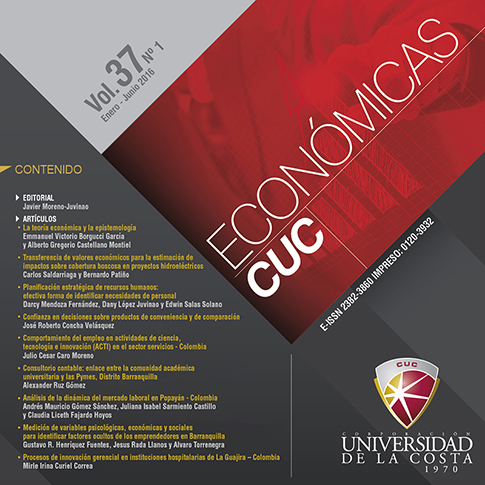Confianza en decisiones sobre productos de conveniencia y de comparación
DOI:
https://doi.org/10.17981/econcuc.37.1.2016.04Palabras clave:
confianza, lealtad, valor, productos de conveniencia, productos de comparaciónResumen
El propósito del presente estudio es analizar como interactúan los constructos: confianza en la marca, lealtad en la marca y valor percibido, en la decisión de compra de productos de conveniencia y productos de comparación. Los constructos en este estudio fueron evaluados utilizando escalas de medidas desarrolladas en anteriores investigaciones. Se demuestra que dichos elementos actúan de igual manera cuando se trata de productos de conveniencia y de comparación. Los resultados muestran una fuerte relación entre las variables, explicando como la confianza de marca y el valor influyen positivamente sobre la lealtad en la compra de los consumidores al momento de tomar su decisión en el caso de productos de conveniencia y de comparación.
Descargas
Citas
Abraheem, A. (2012). The Effect of Brand Trust and Perceived Value in Building Brand Loyalty. International Research. Journal of Finance and Economics, 85. 111-126.
Ballester-Delgado, E. y Aleman-Munuera, J. (2001). Brand Trust in the context of consumer loyalty. European Journal of Marketing, 35(11/12).1238-1258.
Bansal, H., Irving, P., y Taylor, S. (2004). A Three-Component Model of Customer Commitment to Service Providers. Journal of the Academy of Marketing Science, 32(3). 234–250.
Bigne, E. y Blesa, A. (2003). Market orientation, trust and satisfaction in dyadic relationships: A manufacturer retailer analysis. International Journal of Retail & Distribution Management, 31(11). 574–590.
Bloemer, J. y Kasper, H. (1995). The Complex Relationship between Consumer Satisfaction and Brand Loyalty. Journal of Economic Psychology, 16(2). 311-329.
Cadogan, J. y Foster, B. (2000). Relationship Selling and Customer Loyalty: An Empirical Investigation. Marketing Intelligence and Planning, 18(4).185-199.
Chaudhuri, A. y Holbrook, M. (2001). The chain of effects from brand trust and brand affect to brand performance: The role of brand loyalty. Journal of Marketing, 65(2). 81-93.
Cronin, J., Brady, M., y Hult, G. (2000). Assessing the effects of quality, value, and customer satisfaction on consumer behavioral intentions in service environments. Journal of Retailing, 76(2). 193-218.
Cunningham, R. (1956). Brand Loyalty, what, where, how much? Harvard Business Review, 34(1).116-128.
Fullerton, G. (2005). The Impact of Brand Commitment on Loyalty to Retail Service Brands. Canadian Journal of Administratiand Sciences, 22(2). 97-110.
Gounaris, S., Dimitriadis, S. y Stathakopoulos, V. (2005). An examination of the effects of service quality and satisfaction on customers’ behavioral intentions in e-shopping. Journal of services marketing, 24 (2). 142-156.
Hair, J., Anderson, R., Tatham, R. y Black, W. (1998). Multivariate Data Analysis (5th Edition). Upper Saddle River: Prentice-Hall International.
Hess, J. y Story, J. (2005). Trust-based commitment: Multidimensional consumer-brand relationships. Journal of Consumer Marketing, 22(6). 313-322.
Kim, J., y Lee, H. (2008). Consumer product search and purchase behavior using various retail channels: The role of perceived usefulness. International Journal of Consumer Studies, 32(6). 619-627.
Kline, R. (1998). Principles and Practice of Structural Equation Modeling. New York: The Guilford Press.
Lam, S., Shankar, V., Erramilli, M., y Murthy, B. (2004). Customer value, satisfaction, loyalty, and switching costs: An illustration from a business to business service context. Journal of the Academy of Marketing Science, 32(3). 293-311.
Mathwick, C., N. Malhotra, y E. Rigdon (2001). Experiential Value: Conceptualization, Measurement and Application in the Catalog and Internet Shopping Environment. Journal of Retailing, 77(1). 39-56.
McDougall, G. y Levesque, T. (2000). Customer satisfaction with services: putting perceived value into the equation. Journal of Services Marketing, 14(5). 392-410.
Morgan, R. y Hunt, S. (1994). The commitment-trust theory of relationship marketing. Journal of Marketing, 58(7). 20-38.
Nunnally, J. y Bernstein, I. (1994). Psychometric Theory (3 ed.). New York: McGraw-Hill.
Oliver, R. (1999). Whence consumer loyalty? Journal of Marketing, 63(1). 33-44.
Olsen, S. (2002). Comparative Evaluation and the relationship between quality, satisfaction, and repurchase loyalty. Journal of the Academy of Marketing Science, 30(3). 240-249.
Petrick, J. (2002). Development of a Multi-Dimensional Scale for Measuring the Perceived Value of a Service. Journal of Leisure Research, 34(2). 119-134.
Ranaweera, C. y Prabhu, J. (2003). The influence of satisfaction, trust and switching barriers on customer retention in a continuous purchasing setting. International. Journal of Service Industry Management, 14(4). 374-395.
Rosenberg. L. y Czepiel, J. (1983). A Marketing Approach to Customer Retention. Journal of Consumer Marketing, 1(2). 45-51.
Sirdeshmukh, D., Singh, J. y Sabol, B. (2002). Consumer trust, value, and loyalty in relational exchanges. Journal of Marketing, 66(1). 15-37.
Solomon, M., Bamossy, G., Askegaard, S. y Hogg, M. (2006). Consumer Behaviour: A European Perspective 3rd ed. Londres: Pearson Education.
Zeithaml, V. (1988). Consumer perceptions of price, quality, and value: A means-end model and synthesis of evidence, Journal of Marketing, 52(3). 2-22.
Descargas
Publicado
Cómo citar
Número
Sección
Licencia
Usted es libre de:
- Compartir — copiar y redistribuir el material en cualquier medio o formato
- La licenciante no puede revocar estas libertades en tanto usted siga los términos de la licencia
Bajo los siguientes términos:
- Atribución — Usted debe dar crédito de manera adecuada , brindar un enlace a la licencia, e indicar si se han realizado cambios . Puede hacerlo en cualquier forma razonable, pero no de forma tal que sugiera que usted o su uso tienen el apoyo de la licenciante.
- NoComercial — Usted no puede hacer uso del material con propósitos comerciales .
- SinDerivadas — Si remezcla, transforma o crea a partir del material, no podrá distribuir el material modificado.
- No hay restricciones adicionales — No puede aplicar términos legales ni medidas tecnológicas que restrinjan legalmente a otras a hacer cualquier uso permitido por la licencia.


 English
English
 Español (España)
Español (España)














